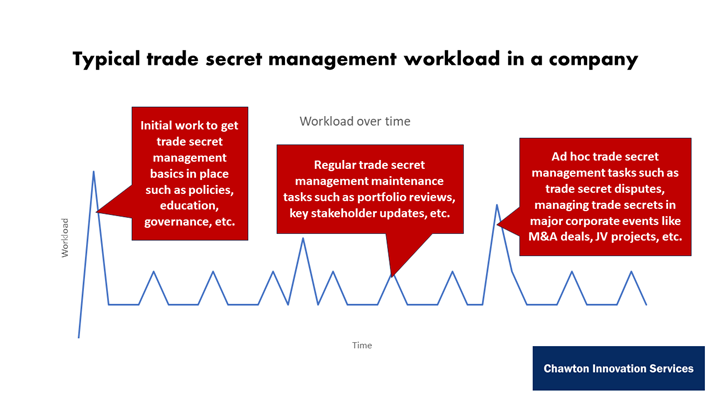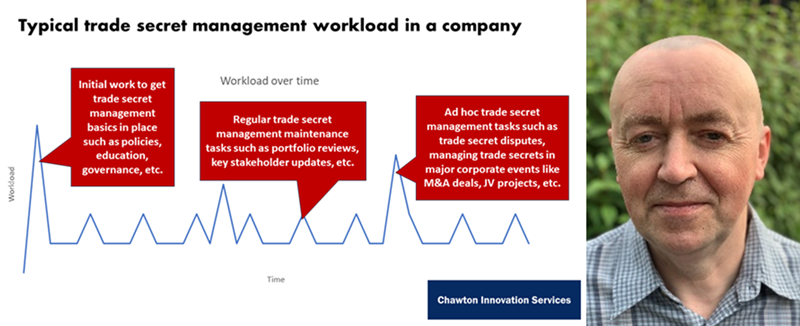Trade secret management – workload within a company
Trade secrets:
Trade secrets constitute an important part of a company’s IP portfolio. And they are generally any valuable business information not known outside of the company. Specifically, for such information to be considered a trade secret, it must fulfil three criteria:
- it must be secret,
- it must have value, providing some actual or potential economic advantage for the company,
- it must be actively protected (i.e. the company must exercise reasonable measures to maintain it as a secret).
Some examples of trade-secret include scientific processes, formulas, product blueprints, algorithms, raw or processed data, software, manufacturing processes, customer lists, financial information, market research studies, internal costing, and pricing information, etc.
Trade secret asset management:
Trade secret management is about the policies and procedure, processes and systems, education and governance defined and taken into use to help manage such ‘assets’. Simply deciding to keep something secret is not sufficient.
Current state:
Many companies have unfortunately tended to ignore trade secrets. Some companies simply lack a good understanding and appreciation of this form of IP. Some mistakenly argue that because they are not a registered form of IP, that they are somehow less important. Some feel uncomfortable dealing with trade secrets as the management of such assets poses some unique challenges. Some will say that all their IP processes and systems are geared to only handling registered forms of IP, and trade secrets disrupt things.
An important part of a company’s IP portfolio:
Trade secrets are an important part of any IP portfolio. It is no exaggeration to say that virtually every business potentially possesses trade secrets, regardless of the size of the business or the industry sector in which it operates.
A few companies understand this and therefore take trade secrets and trade secret asset management seriously.
Trade secret management maturity ladder:
The level of sophistication with respect to trade secret management is not the same at every company.
Some companies are very advanced, protecting their trade secrets and utilizing this form of IP to gain a sustainable competitive advantage, while others are in their infancy, trying to understand the basics of trade secrets.
The trade secret management maturity model is a framework that describes an improvement path from an ad-hoc, immature approach to trade secret management to a mature, disciplined sophistication approach.
The trade secret management maturity ladder consists of well-defined steps or stages.
As a company moves up the ladder, its in-house IP function moves from passive to active to proactive to persuasive with respect to trade secrets as it interacts with the various business units and corporate functions in the company.
The company as a whole moves from having simple recognition of trade secrets down the base of the ladder to activism about trade secrets towards the top of the ladder.
Workload moving up the trade secret management maturity ladder:
‘Workload’ is a measure of how occupied an individual, group or organisation is with work. ‘Workload’ is the amount of resources and time it takes to complete a task or generate an outcome.
How much resource and time is needed by a company when it starts to take trade secret management seriously? This is a common question asked by companies when starting their journey.
Background:
The information on workload in this short article is based on my own experience from working with almost 200 diverse companies over the past decade on trade secret management issues. Some of these relationships were extremely close whereas others less so. Most of these companies did not have a dedicated full time trade secret manager while a few did.
Plotting volume of work over time:
I suggest that the workload is unlikely to be consistent over time and may be divided into three main areas:
- Initial workload to put the basic foundations of trade secret management in place.
- Regular maintenance work to keep everything ticking over nicely.
- Ad-hoc activities that arise from time to time and need to be addressed.

Putting the basic foundations in place:
Trade secret management is dependent on some good foundations being put in place within the organization. These include employee education and training so that everyone gains a good basic understanding and appreciation of such assets; the creation and deployment of a trade secret policy and adjusting other related policies where necessary; defining a robust trade secret process for how such assets should be handled; putting a trade secret asset management system in place if the volume of such assets is considerable; and defining and implementing some governance structure so that there is management attention being paid.
Maintenance work:
The trade secret management workload includes regular maintenance tasks to keep everything ticking over nicely. These include regular portfolios reviews of the assets, sanity checking that policy and processes are robust and fit for purpose and adjusting if and when needed, monitoring the appropriate KPIs and metrics and reacting accordingly. Trade secrets are fragile assets so require lots of ‘tender loving care’.
Ad-hoc work tasks:
Ad-hoc work tasks will arise. Unfortunately, disputes may arise. We are clearly seeing more trade secret related disputes taking place so this should not come as a surprise to any company. I appreciate that when it happens, it is not pleasant.
If the company is going through any major corporate event such as an investment round, an M&A deal, a JV project, then the trade secret management workload may increase as trade secrets are oftentimes a key aspect of such events.
Insights from those at the coal face:
I interviewed several corporate trade secret managers when drafting this article. Many agreed with the workload profile described but a few disagreed or suggested some changes.
One made the following observations:
“The initial workload, depending on the start maturity level at the company where trade secret management is being set up is significant, whereas the portfolio management and maintenance is largely calculable and dispersed. The only ad hoc event that may create extra and unpredictable workload is related to misappropriation and this thankfully does not happen to every organization.
All in all, I recommend to show a large initial peak followed by a plateau that lasts a few months, and then a relatively flat graph for the rest, perhaps with smaller peaks upon annual audits.”
Another made this comment on the initial workload:
“I agree in general but would change the workload profile slightly.
Firstly, the graph should be modified to emphasize there is considerable up-front work and then a steady stream with the occasional bump in the road.
I suggest that there is a step to the left, a pre-step if you like. Learning what trade secrets are, learning why you need to take them seriously, and getting stakeholder or corporate buy in to begin the journey you have depicted. This may be viewed as an exploration phase for the company.”
Summary:
Trade secrets are an important, but oftentimes an invisible component of a company’s IP portfolio of assets. However, trade secrets can also be the crown jewels within the portfolio.
I trust that this short article that explores the subject of the workload associated with trade secret management is of interest and of value.
Any and all feedback is most welcome.
About the blogpost author:
 Donal O’Connell is the founder and Managing Director of Chawton Innovation Services Ltd, a company focused on intellectual property education and training; IP consultancy; and IP solutions & tools.
Donal O’Connell is the founder and Managing Director of Chawton Innovation Services Ltd, a company focused on intellectual property education and training; IP consultancy; and IP solutions & tools.
Donal has delivered a range of IP educational programs over the years, a mix of basic education as well as masterclasses for a diverse range of clients. His company has also expanded into e-learning offering a comprehensive e-learning solution for employees e-learning.



